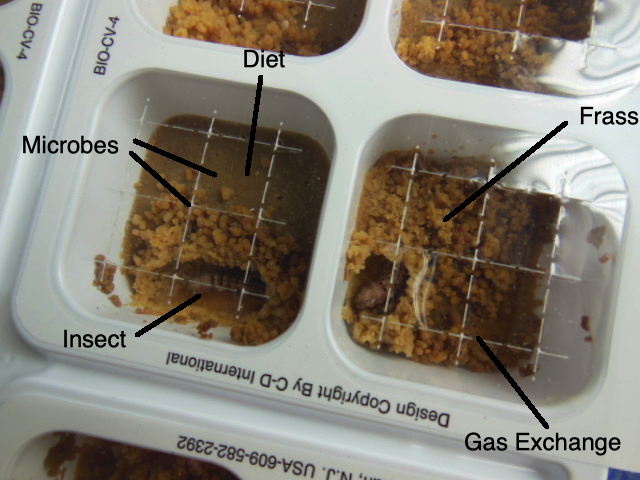
The above image (Figure 1) shows pre-pupal larvae being reared on a wheat germ diet derived from the Yamamoto 1969 tobacco hornworm diet. In this figure, a few of the “moving parts” of the rearing system are depicted, the insect, the diet, frass, and slits in lidding for gas exchange. There is also an indication that microbes are ever-present in rearing systems, within the insects, in the frass, and other parts of the rearing system. Still more features are present in this rearing sub-system, including the environmental conditions such as temperature, humidity, light qualities (including photo-phases, light intensity, and light quality). Sounds and odors also help comprise the insects’ environment as are container configuration and population density (number of individuals per unit of container volume). Many examples of the potential complexity and intricacy are prominent features of rearing systems that are helpful to understand; take microbes, for example.
Various microbial interactions are possible in the rearing system.

In Figure 2, the greenish background is a colony of fungi that grew on an insect diet where the moisture content was too high. In the upper foreground, the black and white image shows the partially-dissected gut of a lacewing adult with the gut contents shown to include yeast which are part of the rearing diet of the lacewings and which also reside in the insect’s specialised, diverticulum-based gut where the yeast thrive as symbionts with the host adult. The lower left picture shows whitefly larvae with their characteristic mycetomes (paired reddish structures), and the image on the lower right shows microbial inhabitants of the gut of termites. Besides these relationships of insects with symbionts (which are mutualists with the insects) and contaminants, there are also possible relationships with pathogenic microbes. ALL of these relationships must be understood to help keep our insects thriving (unstressed and displaying homeostasis) in the colonies that we house in our rearing systems. More on this in the next post. Please note the table (taken from Cohen 2021: Design, Operation, and Control of Insect Rearing Systems, CRC Press). I will comment further on this table in the next post.
Figure 6.1. Simplified Niche Parameters Expressed in an N-Dimensional Hypervolume. Figure 6.1 depicts the idea that there are many facets of niches, represented as intersecting or overlapping vectors. The intersections represent the concept that niche parameters are interactive.
| Niche Parameters | Range of Niche Parameters |
| Starter Insects’ Genetic Characteristics | Full genome characteristics, including genetic diversity |
| Food/diets | Type & amount of food eaten |
| Waste products | Nitrogenous wastes, moisture, undigested food |
| Gas exchange | CO2 output, O2 intake |
| Moisture exchange | Water ingested, evaporatedInsects’ effects on humidity in rearing container through cuticular, respiratory, and fecal water loss, cuticular and respiratory water loss, osmotic values of water in aquatic systems |
| Light relations | Effects of photoperiod, light intensity, and light quality (including possible other electromagnetic spectrum wavelengths such as UV and IR |
| Microbial relations | Beneficial microbes, pathogens, commensals, etc. |
| Population density | How many individuals/unit of rearing space? |
| Population dynamics | Gregarious vs. solitary, agonistic behavior, competition, group digestion, group thermal regulation, etc. |
| Effects on substrate (biting, lidding, etc.) | Degrade container by biting holes, webbing to “manage” frass, digging and conditioning soil, pH of water for aquatics, etc. |
| Mating conditions | Ratios of ♂/ ♀; number of adults, environmental conditions, space for courtship, pheromone plumes, etc. |
| Oviposition conditions | Materials for egg inserters, conduce conditions for egg-laying & egg development/egg hatch |
| Populations of competitors (e.g. mites and psocids) | Often on plants used to rear insects and sometimes on artificial diets (see text discussion for details) |
| Populations of parasites/predators | The large biomass and populations of mass-reared insects offer a target for cryptic parasitoids and predators |
| Thermal relations | Temperature tolerances and optima influence the success or reared insects and further influence susceptibility to microbial attacks |
| Silk utilization/dynamics | Multifunctional uses of silk are discussed in the text |
| Effects of other (than silk) secretions: extra-oral fluids | e.g., glandular secretions, oral/salivary secretions, modifying nutritional quality and bioavailability |
| Scales (as dust hazards, etc.) | Potential for microbial transfers, influencing gas exchange, debris |
| Waste products | Nitrogenous wastes as toxins, substrates for microbial growth, blocking normal food ingestion by clutter, etc. |
| Gas exchange | Range of O2 uptake and CO2output on cultured insects, dispersal of O2 and CO2 in containers |
| Insectary soundscape/vibration-scape | Factors that interfere with auditory communication (stray noise) or vibrations that produce stress or induce excessive responses |
| Factors involved in oxidative stress | Factors in diet or environment that generate free radicals or reactive oxidative species in insects |
Table 6.1. Niche parameters in rearing systems.
